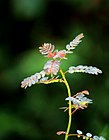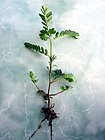Note: This is a project under development. The articles on this wiki are just being initiated and broadly incomplete. You can Help creating new pages.
Difference between revisions of "Phyllanthus urinaria - Bhumyamalaki"
(→Habit) |
(→Habit) |
||
| (26 intermediate revisions by 2 users not shown) | |||
| Line 1: | Line 1: | ||
| − | |||
| − | |||
[[File:Phyllanthus-urinaria.jpg|thumb|right|''Bhumyamalaki'', ''ujjhata'', ''Phyllanthus-urinaria'']] | [[File:Phyllanthus-urinaria.jpg|thumb|right|''Bhumyamalaki'', ''ujjhata'', ''Phyllanthus-urinaria'']] | ||
| − | + | '''Phyllanthus-urinaria''' is a small annual herb growing up to 2 ft tall. Leaves are alternately arranged along the erect. flowers are greenish white, minute and appear at axiles of the leaves, as well as the seed capsules. Numerous small green-red fruits, round and smooth, are found along the underside of the stems. | |
| − | |||
| − | |||
==Uses== | ==Uses== | ||
| − | {{Uses| | + | {{Uses|Kidney stones}}, {{Uses|Urinary tract infection}}, {{Uses|Bladder inflammation}}, {{Uses|Liver problems}}, {{Uses|Hepatitis B}}, {{Uses|Urinaria}}. |
==Parts Used== | ==Parts Used== | ||
| − | {{Parts Used| | + | {{Parts Used|Whole plant}}. |
==Chemical Composition== | ==Chemical Composition== | ||
| − | Lignans Phyllanthin, hypophyllanthin, Flavonoids Astragalin, rutin, quercetin, Triterpenes Lupeol, sitosterol, Alkaloids, Tannin<ref name="chemical composition"/> | + | Lignans Phyllanthin, hypophyllanthin, Flavonoids Astragalin, rutin, quercetin, Triterpenes Lupeol, sitosterol, Alkaloids, Tannin.<ref name="chemical composition"/> |
==Common names== | ==Common names== | ||
| − | {{Common names|kn= | + | {{Common names|kn=Kempu kirunelli|ml=Chirukizhukanelli|sa=Bhumi amalaki|ta=Civappu kilanelli|te=Erra usirika|hi=Thajarmani|en=Chamber bitter}}. |
| + | |||
| + | ==Properties== | ||
| + | Reference: Dravya - Substance, Rasa - Taste, Guna - Qualities, Veerya - Potency, Vipaka - Post-digesion effect, Karma - Pharmacological activity, Prabhava - Therepeutics. | ||
| + | ===Dravya=== | ||
| + | |||
| + | ===Rasa=== | ||
| + | Tikta (Bitter), Kashaya (Astringent), Madhura (Sweet) | ||
| + | ===Guna=== | ||
| + | Laghu (Light), Ruksha (Dry) | ||
| + | ===Veerya=== | ||
| + | Sheet (Cold) | ||
| + | ===Vipaka=== | ||
| + | Madhura (Sweet) | ||
| + | ===Karma=== | ||
| + | kapha, Pitta, Shamaka | ||
| + | ===Prabhava=== | ||
==Habit== | ==Habit== | ||
| − | {{Habit| | + | {{Habit|Small herb}} |
==Identification== | ==Identification== | ||
===Leaf=== | ===Leaf=== | ||
| − | {{Leaf| | + | {{Leaf|Simple|Oblong-obovate|Leaves are alternately arranged along the erect, red stem, resembling those of the mimosa tree, disposed in two ranges. However, the leaves are not compound, but simple.}}.<ref name="Leaf"/> |
===Flower=== | ===Flower=== | ||
| − | {{Flower| | + | {{Flower|Unisexual|2.5 cm long|Greenish white||Flowers are greenish white, minute and appear at axiles of the leaves, as well as the seed capsules}} |
===Fruit=== | ===Fruit=== | ||
| − | {{Fruit| | + | {{Fruit|Small|||Numerous small green-red fruits, round and smooth, are found along the underside of the stems.|12-20 seeds}} |
===Other features=== | ===Other features=== | ||
==List of Ayurvedic medicine in which the herb is used== | ==List of Ayurvedic medicine in which the herb is used== | ||
| − | |||
==Where to get the saplings== | ==Where to get the saplings== | ||
| Line 40: | Line 51: | ||
==How to plant/cultivate== | ==How to plant/cultivate== | ||
| − | + | It is well adapted to variety of soils at pH ranging from alkaline to neutral and acidic. Plant shows preference for calcareous well drained and light textured soils.<ref name="How to plant/cultivate"/> | |
==Commonly seen growing in areas== | ==Commonly seen growing in areas== | ||
| − | {{Commonly seen| | + | {{Commonly seen|Semi-temperate to tropical conditions}}, {{Commonly seen|High rainfall}}. |
| − | |||
==Photo Gallery== | ==Photo Gallery== | ||
<gallery class="left" caption="" widths="140px" heights="140px"> | <gallery class="left" caption="" widths="140px" heights="140px"> | ||
| − | + | Bhumyamalaki (Sanskrit- भूम्यामलकी) (2951961868).jpg | |
| − | + | ||
| + | |||
| + | Chamber Bitter.jpg | ||
| − | + | ||
| + | Chirukizhukanelli (Malayalam- ചിറുകീയുകനെല്ലി) (6185908631).jpg | ||
| + | |||
| + | Diệp hạ châu.jpg | ||
| + | |||
| + | |||
| + | Gardenology.org-IMG 8035 qsbg11mar.jpg | ||
| + | |||
| + | |||
| + | Gardenology.org-IMG 8036 qsbg11mar.jpg | ||
| + | |||
| + | |||
| + | Gardenology.org-IMG 8037 qsbg11mar.jpg | ||
| + | |||
| + | |||
| + | Gardenology.org-IMG 8038 qsbg11mar.jpg | ||
| + | |||
| + | |||
| + | Hajarmani (Hindi- हजारमणी) (6186426322).jpg | ||
</gallery> | </gallery> | ||
| Line 57: | Line 87: | ||
<references> | <references> | ||
| − | <ref name="chemical composition">[http://citeseerx.ist.psu.edu/viewdoc/download?doi=10.1.1.679.2571&rep=rep1&type=pdf | + | <ref name="chemical composition">[http://citeseerx.ist.psu.edu/viewdoc/download?doi=10.1.1.679.2571&rep=rep1&type=pdf Pharmacology]</ref> |
| − | <ref name="Leaf">[http:// | + | <ref name="Leaf">[http://www.flowersofindia.net/catalog/slides/Chamber%20Bitter.html Morphology]</ref> |
| − | <ref name="How to plant/cultivate">[ | + | <ref name="How to plant/cultivate">[http://www.techno-preneur.net/technology/project-profiles/food/bhumy.html Agritechnology]</ref> |
</references> | </references> | ||
==External Links== | ==External Links== | ||
| − | + | ||
| − | + | * [https://easyayurveda.com/2017/05/09/bhumyamalaki-phyllanthus-niruri/ Bhumyamalaki - uses, benefits, side effects, remedies] | |
| + | * [https://herbpathy.com/Uses-and-Benefits-of-Stonebreaker-Cid3662 Bhumyamalaki on herbpathy-make life healthy] | ||
| + | * [http://www.herbalcureindia.com/herbs/bhumyamalaki.htm Bhumyamalaki on herbalcure india] | ||
| + | * [https://www.indiamart.com/proddetail/bhumi-amla-phyllanthus-niruri-extract-11763059348.html Bhumyamalaki on india mart] | ||
[[Category:Herbs]] | [[Category:Herbs]] | ||
| + | [[Category:Phyllanthaceae]] | ||
Latest revision as of 17:16, 1 July 2020
Phyllanthus-urinaria is a small annual herb growing up to 2 ft tall. Leaves are alternately arranged along the erect. flowers are greenish white, minute and appear at axiles of the leaves, as well as the seed capsules. Numerous small green-red fruits, round and smooth, are found along the underside of the stems.
Contents
- 1 Uses
- 2 Parts Used
- 3 Chemical Composition
- 4 Common names
- 5 Properties
- 6 Habit
- 7 Identification
- 8 List of Ayurvedic medicine in which the herb is used
- 9 Where to get the saplings
- 10 Mode of Propagation
- 11 How to plant/cultivate
- 12 Commonly seen growing in areas
- 13 Photo Gallery
- 14 References
- 15 External Links
Uses
Kidney stones, Urinary tract infection, Bladder inflammation, Liver problems, Hepatitis B, Urinaria.
Parts Used
Chemical Composition
Lignans Phyllanthin, hypophyllanthin, Flavonoids Astragalin, rutin, quercetin, Triterpenes Lupeol, sitosterol, Alkaloids, Tannin.[1]
Common names
| Language | Common name |
|---|---|
| Kannada | Kempu kirunelli |
| Hindi | Thajarmani |
| Malayalam | Chirukizhukanelli |
| Tamil | Civappu kilanelli |
| Telugu | Erra usirika |
| Marathi | NA |
| Gujarathi | NA |
| Punjabi | NA |
| Kashmiri | NA |
| Sanskrit | Bhumi amalaki |
| English | Chamber bitter |
.
Properties
Reference: Dravya - Substance, Rasa - Taste, Guna - Qualities, Veerya - Potency, Vipaka - Post-digesion effect, Karma - Pharmacological activity, Prabhava - Therepeutics.
Dravya
Rasa
Tikta (Bitter), Kashaya (Astringent), Madhura (Sweet)
Guna
Laghu (Light), Ruksha (Dry)
Veerya
Sheet (Cold)
Vipaka
Madhura (Sweet)
Karma
kapha, Pitta, Shamaka
Prabhava
Habit
Identification
Leaf
| Kind | Shape | Feature |
|---|---|---|
| Simple | Oblong-obovate | Leaves are alternately arranged along the erect, red stem, resembling those of the mimosa tree, disposed in two ranges. However, the leaves are not compound, but simple. |
.[2]
Flower
| Type | Size | Color and composition | Stamen | More information |
|---|---|---|---|---|
| Unisexual | 2.5 cm long | Greenish white | Flowers are greenish white, minute and appear at axiles of the leaves, as well as the seed capsules |
Fruit
| Type | Size | Mass | Appearance | Seeds | More information |
|---|---|---|---|---|---|
| Small | Numerous small green-red fruits, round and smooth, are found along the underside of the stems. | 12-20 seeds | {{{6}}} |
Other features
List of Ayurvedic medicine in which the herb is used
Where to get the saplings
Mode of Propagation
How to plant/cultivate
It is well adapted to variety of soils at pH ranging from alkaline to neutral and acidic. Plant shows preference for calcareous well drained and light textured soils.[3]
Commonly seen growing in areas
Semi-temperate to tropical conditions, High rainfall.
Photo Gallery
References
External Links
- Ayurvedic Herbs known to be helpful to treat Kidney stones
- Ayurvedic Herbs known to be helpful to treat Urinary tract infection
- Ayurvedic Herbs known to be helpful to treat Bladder inflammation
- Ayurvedic Herbs known to be helpful to treat Liver problems
- Ayurvedic Herbs known to be helpful to treat Hepatitis B
- Ayurvedic Herbs known to be helpful to treat Urinaria
- Herbs with Whole plant used in medicine
- Herbs with common name in Kannada
- Herbs with common name in Hindi
- Herbs with common name in Malayalam
- Herbs with common name in Tamil
- Herbs with common name in Telugu
- Herbs with common name in Sanskrit
- Herbs with common name in English
- Habit - Small herb
- Index of Plants which can be propagated by Seeds
- Herbs that are commonly seen in the region of Semi-temperate to tropical conditions
- Herbs that are commonly seen in the region of High rainfall
- Herbs
- Phyllanthaceae









